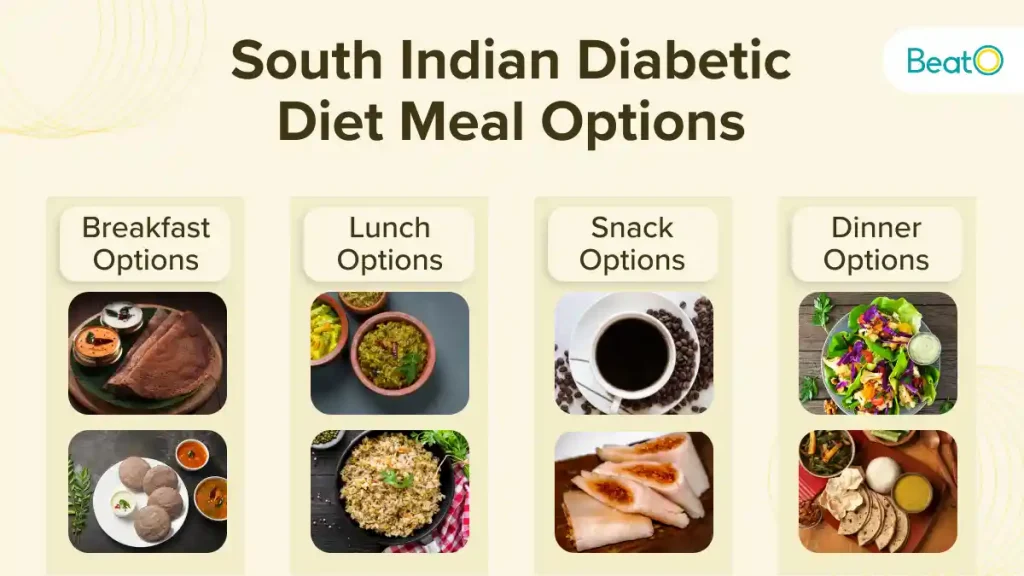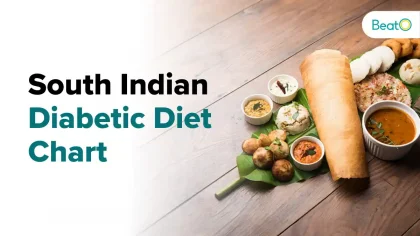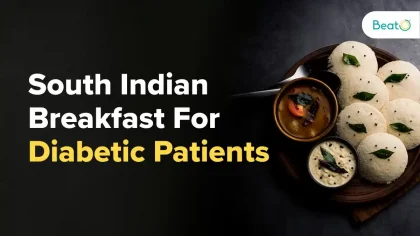South Indian cuisines are known for their rich flavour and diverse ingredients. However, it also offers an array of options that can be tailored to support diabetes management. Moreover, If you’re looking for a South Indian diabetic diet chart? Look no further! We have summarized the diet chart that aligns with your love for traditional flavours while helping you manage diabetes. As you know, managing diabetes requires lifestyle changes, a balanced diet, and regular exercise. These approaches not only manage your blood sugar levels but also keep you healthy.

Moreover, it is quite feasible to have tasty, traditional South Indian lunches and dinners that are also diabetic-friendly for individuals who like South Indian food. Here is the comprehensive weekly diet chart that covers breakfast, lunch, and supper. This guide offers a thorough look at how to create a South Indian meal plan specifically for diabetes.
Also read: 7 Must-Try Vegan Dinner Recipe Ideas
Balanced Diet & Diabetes
Diabetes is a chronic condition characterised by elevated blood sugar spikes. Moreover, if you adopt a healthy and balanced diet, it is quite easily managed. Eating nutritious, timely, proper meals and lifestyle practices can effectively help manage this chronic condition. In addition, speaking with a nutritionist is a must to tackle this long-term illness effectively. Nutritionists can provide appropriate South Indian diabetic diet charts that suit your body type and make and adhere to a type 2 diabetes diet chart.
Moreover, adhering to a diabetes-friendly eating plan on a regular basis is necessary for good diabetic management. However, not everyone can follow a specific eating plan. In addition, the proper food must be consumed in the right amount at the right time to control blood sugar levels.
Also read: Discover The Top 10 Vegan Curry Recipes
South Indian Diabetic Diet: Key Components

So, what are the key components of the South Indian Diabetic Diet? Well, it includes lean meats, vegetables, whole grains, legumes, and healthy fats, whereas processed carbohydrates and high-glycemic meals are kept to a minimum. Here are the key components of the South Indian diabetic diet:
High Fiber: To aid with blood sugar regulation, choose whole grains such as brown rice, millet, and whole wheat. Fruits, vegetables, barley, quinoa, and oats are also high in fibre.
Eat Moderate Carbohydrates: To avoid blood sugar spikes, consume a balanced diet of carbohydrates.
Moderate consumption of nuts, seeds, and coconut oil is a good source of healthy fats. Whole grains like wheat or barley, legumes like beans and lentils, and low-fat dairy products like milk and cheese are additional healthful carbohydrates.
Proteins: Eating a diet high in proteins will aid in stabilizing the body’s blood sugar levels. Lentils, beans, fish, eggs, poultry, and tofu are good sources of healthy proteins.
Healthy Fats: These include avocados, nuts (almonds, cashews, and walnuts), cheese, sunflower and sesame seeds, full-fat yoghurt, dark chocolate, and oils (olive, peanut, canola, and extra virgin coconut).
Low Glycemic Index (GI): Look for meals with low to medium GI, such as lentils, leafy green vegetables, and some fruits.
Also read:Top 10 Vegan Salad Recipes That Are Actually Satisfying
South Indian Diabetic Diet Chart
This comprehensive South Indian diabetic diet chart offers a range of delicious and nutritious traditional South Indian meals.
| Meal | Option 1 | Option 2 | Option 3 | Option 4 |
|---|---|---|---|---|
| Breakfast | 2 Ragi Dosas with limited coconut chutney | 2-3 Idlis with coconut chutney | Rice Puttu with vegetable curry | Appam with vegetable stew |
| Upma with broken wheat and vegetables | Upma with quinoa and vegetables | Upma with flattened rice and vegetables | – | |
| Lunch | One bowl of brown rice with poriyal | One bowl of broken millet with poriyal | One bowl of curd rice with added nuts or seeds | 2 chapatis with dal and vegetable salad |
| Snacks | 1 cup of tea or coffee (without sugar) | Steamed adai | Steamed kozhukatta | One bowl of poha with vegetables and nuts |
| Dinner | One bowl of vegetable salad | 2 wheat chapatis with dal and vegetables | Oats porridge with vegetables | Wheat porridge with vegetables |
South Indian Diabetic Diet: Details of Each Meal Option
Breakfast:
- Ragi Dosa or Idlis with Chutney:
- Description: Fermented dishes made with finger millet (ragi) or rice paired with a side of coconut chutney.
- Benefits: High in fibre and low in glycemic index, making them suitable for maintaining blood sugar levels.
- Rice Puttu with Vegetable Curry:
- Description: Steamed cylindrical rice cakes served with a hearty vegetable curry.
- Benefits: Provides a good balance of carbohydrates and proteins.
- Appam with Vegetable Stew:
- Description: Soft, lacy pancakes paired with a rich, creamy vegetable stew.
- Benefits: Low in fat and rich in complex carbohydrates and fibre.
- Upma:
- Broken Wheat: Nutritious and high in fibre.
- Quinoa: Packed with protein and essential amino acids.
- Flattened Rice: Light on the stomach and low in glycemic index.
Lunch:
- Brown Rice or Broken Millet with Poriyal:
- Description: Whole grains paired with a vegetable stir-fry made from carrots, beans, and cabbage.
- Benefits: High in fibre and nutrients, with a low glycemic index.
- Curd Rice with Nuts or Seeds:
- Description: Yogurt mixed with rice, garnished with healthy nuts or seeds.
- Benefits: Probiotic-rich and beneficial for digestion and blood sugar control.
- Chapatis with Dal and Vegetable Salad:
- Description: Whole wheat flatbreads served with a protein-rich lentil curry and fresh vegetable salad.
- Benefits: Provides a balanced intake of carbohydrates, proteins, and vitamins.
Snacks:
- Tea or Coffee without Sugar:
- Description: A comforting beverage, best consumed without added sugar to avoid blood sugar spikes.
- Benefits: Helps in managing blood sugar levels when consumed without sugar.
- Steamed Adai:
- Description: Savory lentil pancakes that are high in protein and fibre.
- Benefits: It is low in fat and helps maintain steady blood sugar levels.
- Steamed Kozhukatta:
- Description: Steamed rice dumplings that are light and easy to digest.
- Benefits: Low glycemic index, making it a great snack for diabetics.
- Poha with Vegetables and Nuts:
- Description: Flattened rice sautéed with vegetables and garnished with nuts.
- Benefits: Low glycemic index and high in fibre and nutrients.
Dinner:
- Vegetable Salad:
- Description: A fresh salad made with a variety of raw vegetables.
- Benefits: Low in calories and rich in vitamins and fibre.
- Chapatis with Dal and Vegetables:
- Description: Whole wheat flatbreads served with lentil curry and a side of cooked vegetables.
- Benefits: Provides a balanced mix of proteins and carbohydrates.
- Oats Porridge with Vegetables:
- Description: Oatmeal cooked with vegetables for a savoury and nutritious meal.
- Benefits: High in fibre and beneficial for blood sugar control.
- Wheat Porridge with Vegetables:
- Description: A savoury porridge made from cracked wheat and vegetables.
- Benefits: High in dietary fibre and helps in keeping blood sugar levels stable.
Also read:7-Day Vegan Diet Plan For Weight Loss: Is It A Myth?
Advantages of the South Indian Diabetic Diet
The South Indian diet chart for diabetes mostly includes plant-based, low-carb, high-fibre recipes ideal for people with diabetes. Fruits and vegetables, nuts and legumes, whole grains, and low-fat dairy products are staples of the South Indian Diabetic Diet Chart. Less oil or no deep-fried recipes are mostly utilised to manage diabetes.
People with diabetes can greatly benefit from a low-carb diet because high-carb foods can raise blood sugar levels. In addition, South Indian food has a high fibre content that aids in reducing stomach acidity, delaying glucose absorption, and averting blood sugar spikes.
Conclusion
To sum up, the South Indian diabetic diet chart will greatly help in managing diabetes. Also, you don’t have to give up on delectable South Indian food to manage your diabetes. You can enjoy a range of conventional meals while keeping your blood sugar levels in check by making thoughtful decisions and adhering to a balanced eating plan. This comprehensive guide provides you with a satisfying and wholesome diabetic diet that complements South Indian cooking customs. Always seek the advice of a nutritionist or healthcare professional for specific guidance.
Disclaimer: The content of this article is compiled information from generic and public sources. It is in no way a substitute, suggestion, or advice for a qualified medical opinion. Always consult a specialist or your own doctor for more information. Beato App does not claim responsibility for this information.
Are you looking for the perfect glucometer to check your blood sugar level? Try out BeatO smartglucometerkit, affordable and easy to use.
Discover top-tier diabetes care with BeatO’s Chief Clinical Officer,Dr. Navneet Agarwal. His expertise in Diabetes ensures personalised guidance for overall health. Try out a smartglucometerand keep track of blood sugar levels now.




